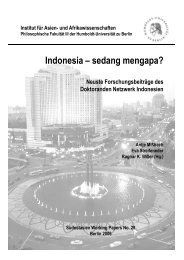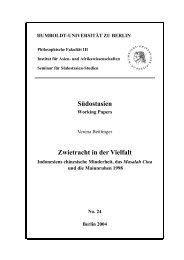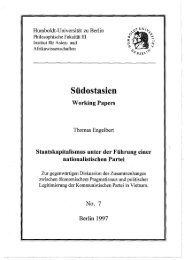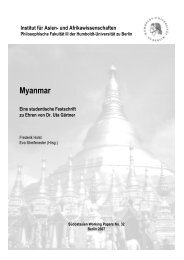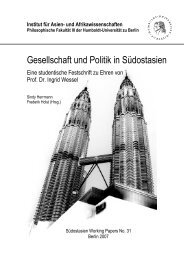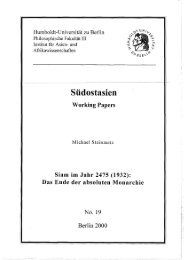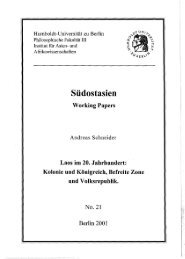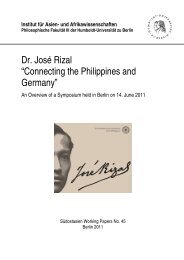On Centrism and Dualism - Humboldt-Universität zu Berlin
On Centrism and Dualism - Humboldt-Universität zu Berlin
On Centrism and Dualism - Humboldt-Universität zu Berlin
You also want an ePaper? Increase the reach of your titles
YUMPU automatically turns print PDFs into web optimized ePapers that Google loves.
CENTRISM AND DUALISM<br />
strategy for perpetuating <strong>and</strong> increasing the house estate. Both marriage strategies, exogamy<br />
<strong>and</strong> endogamy, were practiced concurrently, one to increase access to property <strong>and</strong> the other<br />
to prevent portions of the estate from leaving the house in marriage (ibid.: 182-183). 67 With<br />
regard to this explicit emphasis on affinal strategies, marriage becomes the most important<br />
social principle in LÉVI-STRAUSS conception of houses; a fact that situates the concept of<br />
house societies neatly in his former theory of affinal alliance (GILLESPIE 2000b: 26) <strong>and</strong> yet<br />
another proof of LÉVI-STRAUSS’ general belief in the structural significance of affinity.<br />
In order to further develop his argument <strong>and</strong> to highlight that the house represents a social<br />
category <strong>and</strong> not merely an architectural form or the locus of a household, LÉVI-STRAUSS<br />
turned to medieval <strong>and</strong> early modern Europe. In their characterization of the noble houses of<br />
Europe historians had described the similar kind of social entity that had confounded BOAS<br />
<strong>and</strong> KROEBER in North America.<br />
The medievalist Karl SCHMIED (1957) characterized the medieval house as something quite<br />
different from a family or lineage. The noble ‘lineage’(Adelsgeschlecht) constituting the<br />
house, does not coincide with the agnatic line <strong>and</strong> is often devoid of a biological basis, instead<br />
consisting of a “spiritual <strong>and</strong> material heritage, comprising dignity, origins, kinship, names<br />
<strong>and</strong> symbols, position, power <strong>and</strong> wealth, which once assumed […] took account of the<br />
antiquity <strong>and</strong> distinction of the other noble lineages” (LÉVI-STRAUSS 1982: 174). LÉVI-<br />
STRAUSS points out that in this case, the analytic language of the historian <strong>and</strong> anthropologist<br />
resemble each other.<br />
His [Lévi-Strauss’s, B.B.] definition emphasizes the perpetuation of, <strong>and</strong> the maintenance of an<br />
estate by, a personne morale, a long-lived entity subject to rights <strong>and</strong> obligations. The “language”<br />
of kinship <strong>and</strong>/or affinity is employed to achieve these twinned goals by providing the means to<br />
legitimate the intact transfer of the estate across generations of house members (GILLESPIE 2000b:<br />
27).<br />
Even though LÉVI-STRAUSS’ originally came up with his house concept in the context of<br />
analyzing patrilineal societies (cf. GILLESPIE 2000b: 28), he later focused his attention on<br />
cognatic societies, especially those of Austronesia.<br />
Cognatic kinship systems, in which kinship status is accounted equally through both parents,<br />
had for a long time troubled scholars, who, according to the premises of descent theory, were<br />
used to identify unilineal principles at the heart of social organization. In addition to the term<br />
67 “As was seen in connection with the Kwakiutl, exogamous marriage is used to capture titles endogamous<br />
marriage is used to prevent their leaving the house once they have been acquired. It is therefore a good strategy<br />
to use the two principles concurrently, according to the time <strong>and</strong> opportunity, in order to maximize gains <strong>and</strong><br />
minimize losses.” (LEVI-STRAUSS 1982: 183)<br />
36



